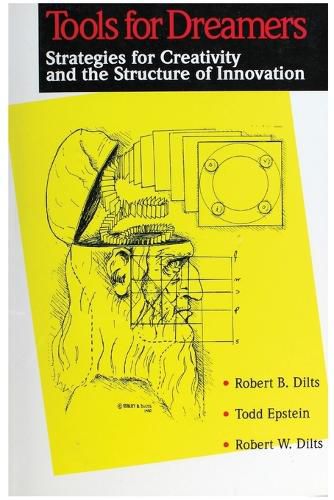Readings Newsletter
Become a Readings Member to make your shopping experience even easier.
Sign in or sign up for free!
You’re not far away from qualifying for FREE standard shipping within Australia
You’ve qualified for FREE standard shipping within Australia
The cart is loading…






This title is printed to order. This book may have been self-published. If so, we cannot guarantee the quality of the content. In the main most books will have gone through the editing process however some may not. We therefore suggest that you be aware of this before ordering this book. If in doubt check either the author or publisher’s details as we are unable to accept any returns unless they are faulty. Please contact us if you have any questions.
Thomas Edison said that the process of invention is 1% inspiration and 99% perspiration. The implication of this statement is that most creative activity is in fact an incremental process that has a structure and requires organization and constant effort to maintain. In many ways, however, creativity has remained elusive–a seemingly mysterious gift that you either have or you don’t have–rather than a set of skills that can be transferred and managed systematically and explicitly.
Neuro-Linguistic Programming (NLP) provides a set of tools that can allow us to take major steps toward the overcoming of this limitation. The field of Neuro-Linguistic Programming has developed out of the modeling of human thinking skills. The NLP modeling process involves finding out about how the brain ( Neuro ) is operating by analyzing language patterns ( Linguistic ) and non-verbal communication. The results of this analysis are then put into step-by-step strategies or programs ( Programming ) that may be used transfer the skill to other people and applications.
NLP provides a way to look past the behavioral content of what people do to the more invisible forces behind those behaviors; to the structures of thought that allow people to perform effectively. NLP provides a framework and a language that allows one to model the relevant mental strategies used by creative and innovative people so that those inner processes can be communicated about, stimulated and managed in a systemic way. Through NLP, we can:
define the creative process of an individual, group and organizational level. create a vocabulary that will support and enhance the creative process. provide specific ways people can more effectively support, enhance and direct creativity in individuals and teams. determine ways to identify different types of creative people.
The purpose of this book is to examine the structure and principles of creativity in order to enhance and supplement the creativity and productivity of individuals, teams and organizations. The behavioral technology provided by Neuro-Linguistic Programming makes explicit the strategies and steps involved in the creative process on a number of different levels, including:
stimulating personal creativity: enhancing day-to-day creativity and flexibility on a personal level. managing group creativity: Stimulating innovation within the dynamic patterns of groups and teams. promoting entrepreneurial beliefs and attitudes.
$9.00 standard shipping within Australia
FREE standard shipping within Australia for orders over $100.00
Express & International shipping calculated at checkout
This title is printed to order. This book may have been self-published. If so, we cannot guarantee the quality of the content. In the main most books will have gone through the editing process however some may not. We therefore suggest that you be aware of this before ordering this book. If in doubt check either the author or publisher’s details as we are unable to accept any returns unless they are faulty. Please contact us if you have any questions.
Thomas Edison said that the process of invention is 1% inspiration and 99% perspiration. The implication of this statement is that most creative activity is in fact an incremental process that has a structure and requires organization and constant effort to maintain. In many ways, however, creativity has remained elusive–a seemingly mysterious gift that you either have or you don’t have–rather than a set of skills that can be transferred and managed systematically and explicitly.
Neuro-Linguistic Programming (NLP) provides a set of tools that can allow us to take major steps toward the overcoming of this limitation. The field of Neuro-Linguistic Programming has developed out of the modeling of human thinking skills. The NLP modeling process involves finding out about how the brain ( Neuro ) is operating by analyzing language patterns ( Linguistic ) and non-verbal communication. The results of this analysis are then put into step-by-step strategies or programs ( Programming ) that may be used transfer the skill to other people and applications.
NLP provides a way to look past the behavioral content of what people do to the more invisible forces behind those behaviors; to the structures of thought that allow people to perform effectively. NLP provides a framework and a language that allows one to model the relevant mental strategies used by creative and innovative people so that those inner processes can be communicated about, stimulated and managed in a systemic way. Through NLP, we can:
define the creative process of an individual, group and organizational level. create a vocabulary that will support and enhance the creative process. provide specific ways people can more effectively support, enhance and direct creativity in individuals and teams. determine ways to identify different types of creative people.
The purpose of this book is to examine the structure and principles of creativity in order to enhance and supplement the creativity and productivity of individuals, teams and organizations. The behavioral technology provided by Neuro-Linguistic Programming makes explicit the strategies and steps involved in the creative process on a number of different levels, including:
stimulating personal creativity: enhancing day-to-day creativity and flexibility on a personal level. managing group creativity: Stimulating innovation within the dynamic patterns of groups and teams. promoting entrepreneurial beliefs and attitudes.